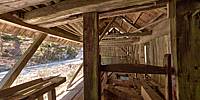
The Psnak sawmill and mill
Radovna River, Triglav National Park, Slovenia
July 17th, 2017 CEST
© 2017 Boštjan Burger, All Rights Reserved.
Since the water power of the upper Radovna River is rather modest, the Psnak mill and saw mill operated only periodically – in Maj and June when the snow on the mountain slopes began to melt , and in September and October during the rain in the fall season. And ever then the same water power was used very economically to turn both wheels.
The mill had only one “black stone” for grinding rye, oats, barley and buckwheat, the type of cereals which grew in the few modest fields in this narrow valley. The Venetian saw used one or most two saw blades, depending on the quantity of water. Sawing along a four-metre spruce with single blade took approximately twenty minutes for the one cut, which means that up to 1 cubic meter of wooden boards could be sawn in a daily shift. The mill and the sawmill operated simultaneously so that from time to time while wood was being cut, the worker would also do the necessary work in the mill. The mill and the sawmill served the Psnak family until the 1970-s- In 1997, however, the owner renovated both objects to preserve evidence of the knowledge and work of the local inhabitants, as well as of their remarkable flexibility, which allowed them to make the most of the area's natural resources and preserve the beauty of the nature.
Lat: 46° 25' 47.54" N
Long: 13° 57' 52.6" E
Elevation: 660 m
Precision is: Medium. Nearby, but not to the last decimal.
Mlin in žaga sta obratovala do sedemdesetih let preteklega stoletja, leta 1997 pa so ju Psnakovi obnovili. S tem so ohranili dokaz o nekdanjem načinu dela, znanju ter iznjdljivosti ljudi, ki so naravne danosti znali uporabiti sebi v prid, hkrati pa ohranili lepoto narave. Vir besedila: informacijska tabla občine Kranjske Gore in Triglavskega narodnega parka, postavljena ob cesti pri Psnakovi žagi.


 Tap or click the zoom icon in the bottom right corner of the picture to switch between in-page and fullscreen view
Tap or click the zoom icon in the bottom right corner of the picture to switch between in-page and fullscreen view